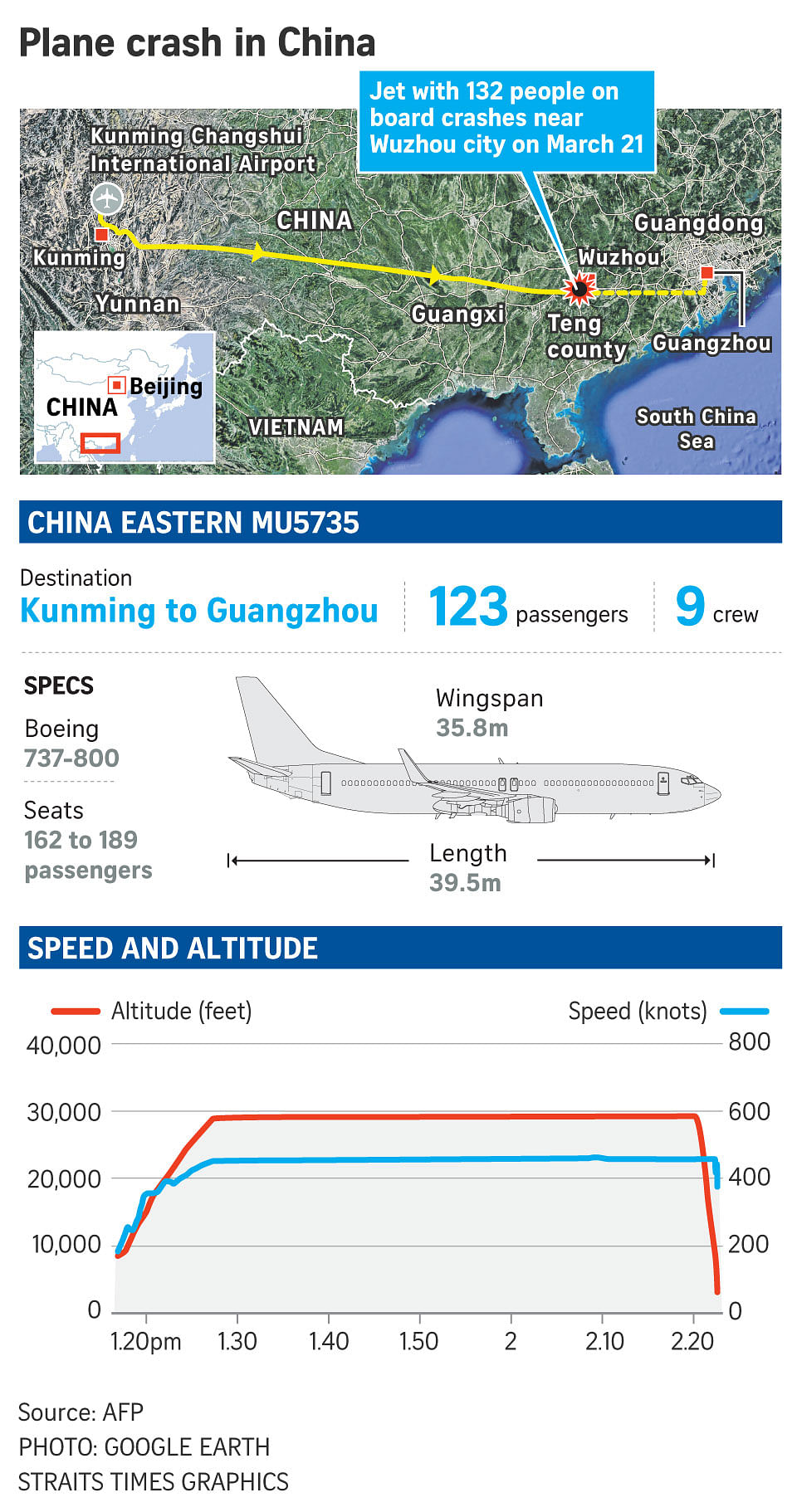China jet's nosedive from 29,000 feet baffles crash specialists
Sign up now: Get insights on Asia's fast-moving developments
Follow topic:
BEIJING (BLOOMBERG) - The China Eastern Airlines jet was flying a normal route to Guangzhou when it suddenly nosed over at cruise altitude and dove. That is about all that is known for certain about the unusual crash that killed all 132 people aboard the aircraft on Monday (March 21) in China's worst aviation accident in more than a decade.
While there have been a handful of crashes in which an airliner plunged from cruising altitude, few, if any, fit the extreme profile of the Boeing 737-800 as it pointed steeply towards the ground, according to veteran crash investigators and previous accident reports.
"It's an odd profile," said aviation safety consultant and former 737 pilot John Cox. "It's hard to get the airplane to do this."
As investigators search for the plane's two crash-proof recorders and begin poring over clues, they will be trying to determine why the jet made such an abrupt and severe dive, which sets it apart from earlier accidents.
They will be looking at the weather the plane encountered, whether the pilots made any distress calls, any hints in the wreckage of possible malfunctions and detailed profiles of the crew.
Flight MU5735 was at about 29,000 ft altitude roughly 100 miles from its destination - about the point at which the pilots would begin descending to land - when it started plunging at a far greater rate than normal.
Instead of gradually dropping by a few thousand feet per minute - which produces a barely detectable sensation for passengers - it began falling at more than 30,000 ft per minute within seconds, according to tracking data logged by Flightradar24.
Overall, it plunged almost 26,000 ft in the span of roughly one minute, 35 seconds, the data track showed. The plane's dive appeared to have halted for about 10 seconds and it climbed briefly, adding an unusual twist to the scenario. But the Flightradar24 track, which is based on radio transmissions from the plane, then showed it resuming a steep plunge.
"It's very odd," said former accident investigation chief for United States Federal Aviation Administration Jeff Guzzetti.
While cautioning that the Flightradar24 data is preliminary, Mr Guzzetti and Mr Cox said the relatively straight track taken by the jet and the fact that its transponders were still broadcasting suggests that it did not break up in flight, as has been seen in some terrorist bombings.
Surveillance video
A surveillance video appearing to capture the plane in its final moments showed it in a steep dive towards the ground. Chinese media outlet The Paper said it had verified that the video was shot by a mining company near where the jet impacted, but its authenticity could not be independently verified.
There are precedents in which airliners suddenly began dropping from cruise altitude, but most of them have important differences, investigators said.
For example, Air France Flight 447, which went down in the Atlantic Ocean on June 1, 2009, fell much slower and more erratically after speed sensors iced up and pilots became confused, according to France's Bureau of Enquiry and Analysis for Civil Aviation Safety. All 228 people aboard the Airbus SE A330 died.
Though it went down from a much lower altitude, an Atlas Air Worldwide Holdings cargo jet dove suddenly into a marsh near Houston on Feb 23, 2019. In that case, the co-pilot became disoriented and pointed the nose towards the ground, the US National Transportation Safety Board (NTSB) found. Its descent occurred over a much shorter period of time and it was not falling as fast the China Eastern plane.
Another crash that was similar occurred on Dec 19, 1997, when a pilot on a Silk Air 737-300 carrying 104 people dove into a river in Indonesia, killing everyone aboard. It was falling at more than 38,000 ft per minute, according to that nation's National Transportation Safety Committee.
A pilot most likely crashed that plane deliberately, the NTSB concluded. But Indonesian investigators and Singapore police said there was insufficient evidence to prove that.
Too soon for conclusions
It is far too early to draw conclusions on what led to the China Eastern crash, said former NTSB investigator Benjamin Berman, who also flew 737s. It is possible to come up with many scenarios for some type of malfunction, pilot miscues or some combination that led to the plunge, he said said. But none of them seem very likely.
He echoed what Mr Cox and Mr Guzzetti said - The 737-800, like other jetliners, is designed so that it will not normally dive at steep angles. That means it would likely take an extreme effort by a pilot or a highly unusual malfunction, he said.
Many things can cause at least the start of a dive - from a pilot suffering a heart attack and slumping onto the control column to a failure of the motor used to help raise and lower the nose. But they would tend to be more short-lived or there are easy ways for pilots to counteract such failures, he said. "You need something to hold the nose down," Mr Berman said.


